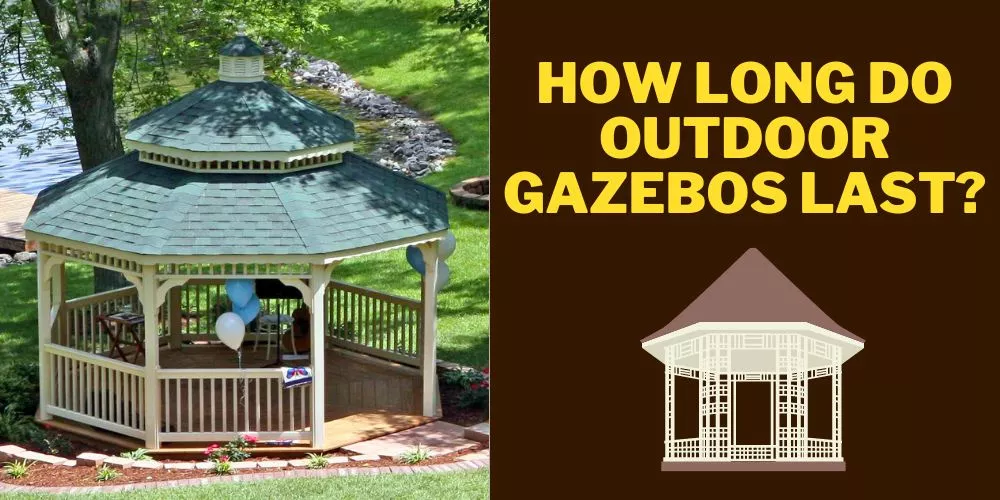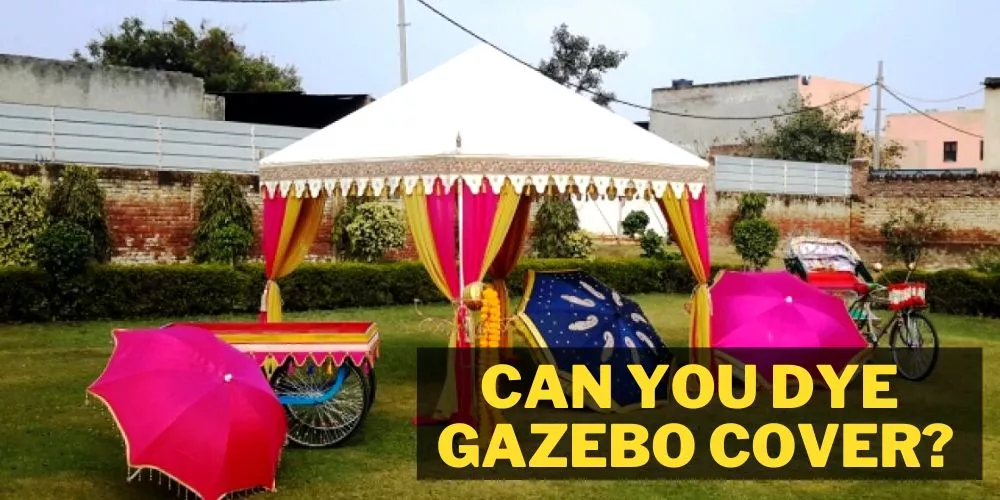When building a gazebo, many facets need to be considered. Especially when the intention is for it to be a permanent structure, these important aspects include the overall planning of the project and the actual build itself. The building process may even involve services such as running water and/or electricity. Here, I will discuss do you need a permit for a gazebo or not.
More often than not, a permit may be required to enable the build to take place. It all depends on the local council’s rules and regulations for a structure of that nature. In this article, we’ll look at when and why permits are required and which type should be applied when building a gazebo.
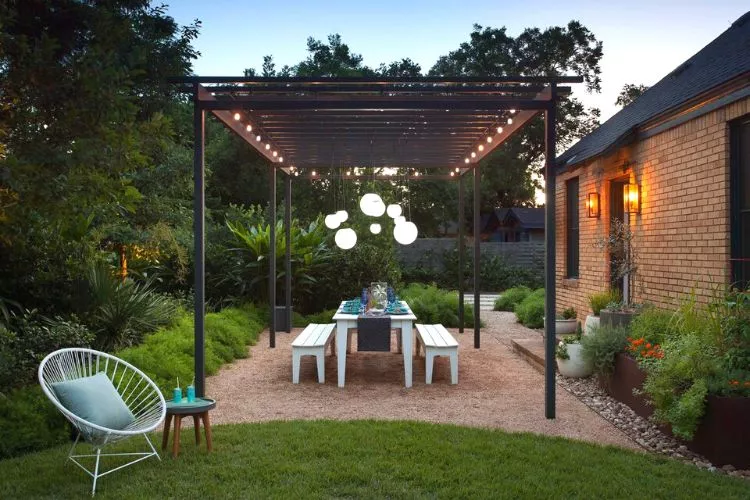
Do you need a permit for a gazebo?
Everyone’s home situation, land area, and potential build requirements are going to vary from each other. That is why it is difficult to directly answer this question. It’s always best to check with your local planning department and HOA before going ahead and making a start with your gazebo. Some US states are ok with building freely, but others are rock solid on toeing the line.
The risk is not worth taking if it means possibly dismantling a built gazebo and starting again. Quite often, you may not only need one permit, either. Planning, building, and adding running water and electricity require separate permits to be applied for. All of them usually need to be signed off with each other to ensure all areas of the gazebo are aligned.
Why Permits Are Required?
Permits aren’t just a governing body giving their approval for you to build; they also provide guidelines and tips on building the structure. For example, how close to a neighboring house or boundary it can be or if it should be in a certain spot to avoid blocking a view.
Permits are usually required for these types of ‘accessory’ structures to ensure they maintain the building codes for that specific region. The standards are created by governing bodies to ensure the safety and well being of those who intend to be on that property and any neighboring property.
Factors Affecting Permit Requirements
Generally, it’s usually safe to build a gazebo structure without a permit if the size doesn’t exceed 100 square feet (10 ft wide x 10 ft long). However, as mentioned earlier, it’s always best to check with your local governing body to ensure everything is above board.
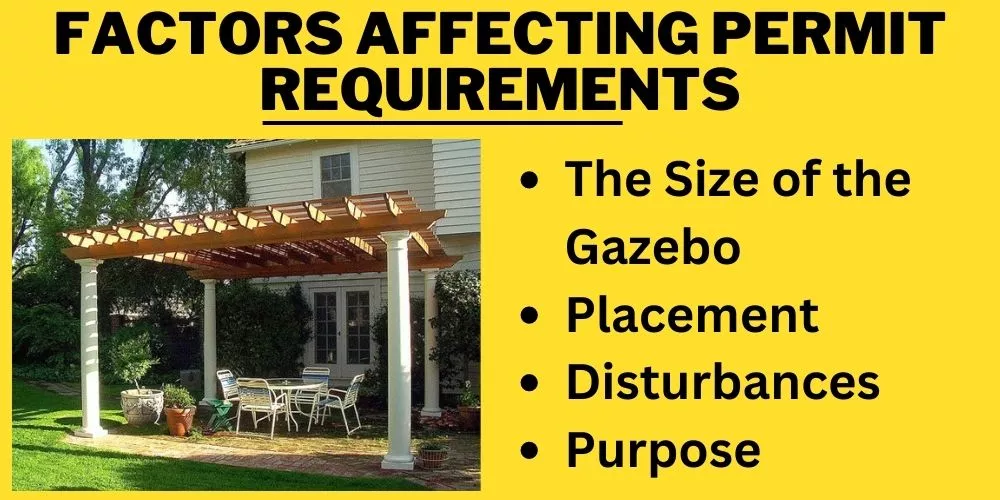
When it comes to applying for a permit for your gazebo, a couple of factors may affect the permit’s requirements. These include:
1. The Size of the Gazebo
The gazebo size is what the rule makers will look at first. Gazebos aren’t generally huge structures, but they can be. If they exceed certain dimensions, they may be considered a small dwelling instead of a gazebo. This will almost guarantee that a permit is needed to go ahead with the build.
2. Placement
Some local councils have rules that don’t allow gazebos to be built within a certain distance of a property’s boundaries. The setback distance of a gazebo is generally 5 ft from the side property line and 10 ft from the rear property line. They also have a 45 degree rule where a gazebo can’t interfere with the line of sight of a 45 degree angle taken from the center of the closest neighboring ground floor window.
3. Disturbances
We often think of just the structure itself, but much work is usually needed to build a footing for the gazebo, regardless of the size. The foundation may also disturb certain environmental aspects that may be of concern to local councils.
Any machinery required for the job also needs access which could cause disturbances for neighboring properties and the environment. These instances may push for the permit to be applied for
4. Purpose
Intended purpose can be a deciding factor when applying for a permit. Installing electricity for power points and lighting, running water, and even gas for a BBQ can need permits. They must be connected to existing lines, dug down in amongst other potentially unknown services, and then properly installed. These factors require delicate work, which a permit can help plan for.
What Permits Are Required for Pergolas and Gazebos?
A range of permits need to be obtained when building dwellings such as houses, garages, pergolas, or gazebos. Each one is required for its specific purpose. No one permit covers all areas. These could be for certain dimensions, water features, weight restrictions, health protocols, electricity, etc.
It could end up that you have 10+ permits depending on the extent of your build. When building a pergola or gazebo, there are generally 4 main permits that are usually applied for. These include:
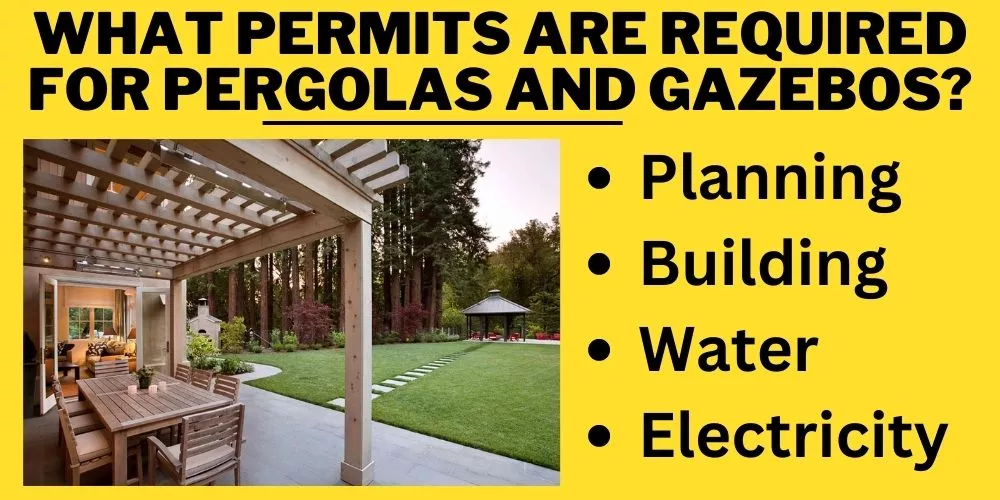
1. Planning
Planning always comes first. It’s the overview of the whole project and states all things that need to be considered and how they should be achieved. A planning permit breaks down all the processes that will be completed from start to finish. This permit also goes through access to the area, traffic disturbances, heavy machinery required, information to surrounding people such as neighbors, etc.
2. Building
The building permit breaks down the planning permit even further, except it focuses solely on the building itself. It details all of the specifics, such as the thickness of the foundation and how it should be reinforced. It will also have an itemized list of all the other required materials and how they should be used. For example, the pitch of the roof and the overlap of the outer edges ensure water runs off.
3. Water
A water permit generally ties into a building permit when installing a finished product, such as the sink and the pipes leading into and out of the gazebo. However, the water must be connected to a supply and waste pipe.
The governing councils will have all this information, and the permit is there to ensure the process runs smoothly. For example, there may be other pipes or services underground that could be dug up and damaged. Permits assist with removing these headaches.
4. Electricity
An electricity permit works similarly to a water permit. The gazebo may need a power supply, depending on the specifications. All installations will be in the building plan, but power supply from outside the boundary needs documents to show where and how to connect as wella s who is qualified to do so.
There may be disturbances in turning the power off for a brief time while the connection is in process. The permits will include notifying anyone in the vicinity of these outages so they can prepare accordingly.
How to Apply for a Permit?
Applying for a permit to build a gazebo may sound daunting. However, it doesn’t have to be. There are two paths that you can take to apply. You can either apply for the permit yourself or hire a contractor to do all of it for you. There are pros and cons to both routes.
Applying for the permit yourself is a great way to be more hands on. You ultimately have full control of the process. However, if you are new to the concepts surrounding building a gazebo, the paperwork involved can become quite messy.

Furthermore, all responsibility is on you, so if you miss something written in the permit and go against it, there can be disruptive consequences. Choosing a contractor to do the paperwork removes much of the stress involved. They already have a process that they follow. They will already have contact with the governing bodies and have all the specifications ready to go.
The only downside may be that they tend to toe the line and will not try to bend any rules for you. The costs involved can also be much higher than doing it yourself. The headache of paperwork seems worth the money, though, in our opinion.
Applying for the permit requires receiving all the correct documentation and filling it in accordingly. Then all of the papers must be signed by all the building participants from start to finish. Once completed, they can be sent back in, where any amendments will be edited.
Finally, there will be some final checks and then a result. Most permits get approved as long as all the local regulations are followed and signed off on.
Frequently Asked Questions (FAQs)
Is a gazebo a permanent structure?
For example, gazebos can be built as a permanent structure in a garden or park. You can also purchase more versatile variants, such as pop ups or hard tops. Pop ups can be packed in a handy carry bag and erected in minutes. Hard tops are more semi-permanent. They are usually set up for long term camping trips or in gardens as an alternative to a complete build. It all depends on the intended use.
How high can you build a gazebo without planning permission?
A gazebo is classified as a garden building. Garden buildings generally need to be under 2.5 m tall when placed 2 meters or closer to a boundary line. They can be built up to 4 m tall when placed further than 2 meters from the boundary line. It’s always best to check with a local council, as regulations can vary depending on location
What is the maximum height for a gazebo?
Every area is different. The best way to get the correct answer is by checking with the local council to ensure no mistakes are made while planning. The height also depends on the gazebos’ intended use. There are cases where people build 18 ft (5.5 m) structures. The standard is usually around 13 ft (4 m), though.
Conclusion:
All in all, applying for a build permit shouldn’t be considered a hassle. If anything, it helps to ensure that your potential build is safe and satisfactory toward yourself and any other neighboring body. Some smaller, simpler gazebo designs might get away without needing paperwork. Others may need many signatures to pass through to build the stage. It’s better to be safe than sorry! We hope this article has been helpful, and we look forward to seeing you at the next one!

